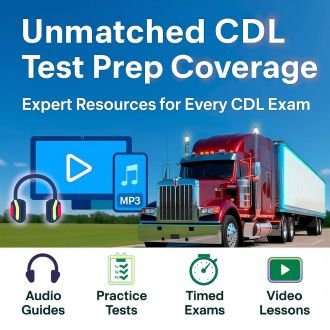Understanding the CDL requirements for getting a CDL (commercial driver’s license) is essential if you want to become a truck driver. These also apply to the CLP or commercial learner’s permit, which you’ll have to get in order to train and before you get a CDL. The Federal CDL requirements (see below) apply to all U.S. states. Then, check out the CDL requirements in your state. Each state has its own minimum standards for the licensing of commercial drivers, and they differ from state to state.
- Minimum Requirements to Apply for a CLP or CDL
- New Federal CDL Requirements
- Medical and Physical Requirements
- CDL Self Certification
- Basic Physical Qualifications for Commercial Drivers
- Written and Knowledge Exams
- Skill and Road Testing
- Military Waiver Information
- CDL Requirements in Your State
Minimum Requirements to Apply for a Commercial Learner’s Permit (CLP) or Commercial Driver’s License (CDL)
- Have a valid regular (non-commercial) driver’s license and be at least 18 years old (in most states).
- Be at least 21 years old:
- To drive a commercial motor vehicle across state lines (interstate).
- To drive a commercial motor vehicle that contains hazardous materials.
- Have at least one or two years of driving experience (depending on the state)
- An applicant “must provide to the State proof of citizenship or lawful permanent residency” per 49 CFR 383.71.
- Social security card, or proof of the number.
- Another document such as a birth certificate or green card.
- Pass all applicable background screens.
- The applicant “must provide the names of all States where the applicant has been licensed to drive any type of motor vehicle during the previous 10 years” – FMCSA.
- Have no active driver’s license suspensions or revocations in any state
- Must surrender your regular state driver license once you earn a CDL.
- Must certify that he/she is not “subject to any disqualification under FMCSA 383.51 (complete list of disqualifications), or any license disqualification under State law, and that he/she does not have a driver’s license from more than one state or jurisdiction”.
- Be able to speak and read English to drive a CMV in the United States. In addition, the state written exams will only be given in English. The FMCSA has more about this here.
New Federal CDL Requirements
There have been several changes over the years in the “compliance requirements” area by the FMCSA (Federal Motor Carrier Safety Administration). Like their name implies, the FMCSA exists to keep U.S. roads safer, mainly by preventing commercial truck related accidents.
- Since the Commercial Motor Vehicle Safety Act of 1986, drivers cannot hold a CDL in more than one state. This ended the practice of drivers getting multiple driver’s licenses and hiding bad records they may have had in a different state.
- New Hazardous Materials Endorsement Requirements. Check out our step-by-step guide on How to Get Your Hazmat Endorsement.
- In late 2013, states had to start enforcing the texting prohibition rule.
- Then, starting in 2014, commercial drivers had to ““self-certify” medical information and were only allowed to use “authorized” medical examiners who are on the National Medical Registry.
More information about these changes can be found from the FMCSA.
Medical and Physical Requirements
The physical demands of the trucker’s job depends on which type of driving he’s doing. But no matter which type, a driver must be physically physically capable of operating a commercial motor vehicle and to perform the varied types of non-driving trucking duties. This includes handling long periods of driving, irregular sleep schedules, potential family and/or social challenges, and job related stress. In addition, some jobs require heavy lifting in the loading/unloading process, twisting and bending, getting in and out of the truck many times a day, occasional (depending where you work) installing of tire chains, and many other possible physical activities.
You must have a valid Medical Examiner’s Certificate (DOT card), or a photographic copy of your valid Certificate, to receive a CDL or CLP. This is a federally mandated (U.S. Department of Transportation) document that certifies you meet all physical and medical standards for operating a commercial motor vehicle and the original or photographic copy must be in your possession whenever you are driving.
CDL Self Certification
Starting in 2014, commercial drivers have to “self-certify” medical information and are only allowed to use “authorized” medical examiners who are on the National Medical Registry. To find a medical examiner who is certified by the FMCSA to perform DOT physical exams click here.
All commercial drivers must now self-certify the type of vehicle they’re going to operate in the following categories:
- Non-Excepted Interstate: This just means that you must meet the Federal DOT medical card requirements and operate across state lines.
- Excepted Interstate: You do NOT have to meet the Federal DOT medical card requirements and operate across state lines.
- Non-Excepted Intrastate: You must meet the Federal DOT medical card requirements and operate only in your home state.
- Excepted Intrastate: You do NOT have to meet the Federal DOT medical card requirements and operate only in your home state.
Basic Physical Qualifications for Commercial Drivers
The Medical Examination Report For Commercial Driver Fitness Determination is a FMCSA form used by medical examiners. This form will give you a good idea of the medical qualifications for drivers, as will the complete list (from FMCSA 391.41) further down on that page.
You are now required to obtain a “Medical Examiner’s Certificate” to prove that you are physically capable of operating a commercial motor vehicle. Some of the requirements are as follows:
- Standard: At least 20/40 acuity (Snellen) in each eye with or without correction. At least 70 degrees peripheral in horizontal meridian measured in each eye. Eye glasses or contact lenses are acceptable, but the use of corrective lenses should be noted on the Medical Examiner’s Certificate.
- You cannot be a diabetic who requires insulin via needle injection. However, note that certain drivers may be exempt.
- Hearing: Standard: a) Must first perceive forced whispered voice > 5 ft., with or without hearing aid, or b) average hearing loss in better ear < 40 dB
- Blood Pressure: Has no current clinical diagnosis of high blood pressure likely to interfere with his ability to operate a commercial motor vehicle safely
- Elevated Blood Sugar levels: 200 or above is considered “dangerous”. However, there appears to be no evidence to support that 200 or more (blood sugar level) is a disqualification, despite this being reported by many other websites. For a discussion of this apparent inaccuracy, see here.
- Other conditions like sleep apnoea may also be a disqualification.
Written and Knowledge Exams
To get a CDL, you must pass knowledge and skills tests. The CDL manual will help you pass the state exams. This manual is not a substitute for a truck driver training class or program. Formal training is the most reliable way to learn the many special skills required for safely driving a large commercial vehicle and becoming a professional driver in the trucking industry.
The person must have taken and passed a general knowledge test – get some more info on which tests to take here or just go to the CDL Practice Test Center and take some tests.
Skill and Road Testing
For the road and skills test you must use the same class of commercial vehicle you need to get licensed for.
The three part driving test includes:
- Pre-Trip Vehicle Inspection – You need to know your vehicle is safe to drive. Sections 11, 12, and 13 of the CDL Manual covers how you need to explain what you are inspecting and for what reason.
- Basic Vehicle Control – You will be tested on your control of your vehicle. This includes moving vehicle forward, backward, and within a defined area.
- On-Road Driving Exam – You will have to demonstrate you can safely drive a commercial vehicle on the road in various traffic situations. (Left and right turns, stopping, curves, railroad crossings, etc.)
Military Waiver
Did you recently drive a CMV (or the military equivalent of commercial motor vehicle) in the military? You may be able to waive the skills test portion of the commercial driver license skills test. Military drivers must apply within one year of separation from active duty.
The Commercial Driver License (CDL) skills test waiver form may be used by service members who are currently licensed and who are or were employed within the last 90 days in a military position requiring the operation of a military motor vehicle equivalent to a Commercial Motor Vehicle (CMV). This waiver allows a qualified service member to apply for a CDL without skills testing. CDL knowledge (written) test(s) cannot be waived. The transfer of School Bus(S) and/or Passenger (P) endorsements under this Waiver Program are prohibited.
- Check out the article “Troops to Trucks program helps military drivers transition into civilian world” for more information.
- Here’s an Application for the Military Skills Test Waiver.
- More information about the Military Waiver can be found from the FMCSA.
CDL Training in Your State
We’ve been helping future truck drivers find CDL training resources and get their CDLs since 2004.
- Get free information about CDL training opportunities from some of the best schools in your area.
- Find your state truck driving schools and CDL resources in our Truck Driving Schools Guide.
- View or download your state’s official CDL manual.
- Learn about the CDL Requirements in your state.
- Take free tests at our CDL Practice Test Center.
Choose your state below and get on the road to becoming a trucker now!
Choose Your State
Jump straight to your state's CDL hub.
- Alabama
- Alaska
- Arizona
- Arkansas
- California
- Colorado
- Connecticut
- Delaware
- District of Columbia
- Florida
- Georgia
- Hawaii
- Idaho
- Illinois
- Indiana
- Iowa
- Kansas
- Kentucky
- Louisiana
- Maine
- Maryland
- Massachusetts
- Michigan
- Minnesota
- Mississippi
- Missouri
- Montana
- Nebraska
- Nevada
- New Hampshire
- New Jersey
- New Mexico
- New York
- North Carolina
- North Dakota
- Ohio
- Oklahoma
- Oregon
- Pennsylvania
- Rhode Island
- South Carolina
- South Dakota
- Tennessee
- Texas
- Utah
- Vermont
- Virginia
- Washington
- West Virginia
- Wisconsin
- Wyoming


